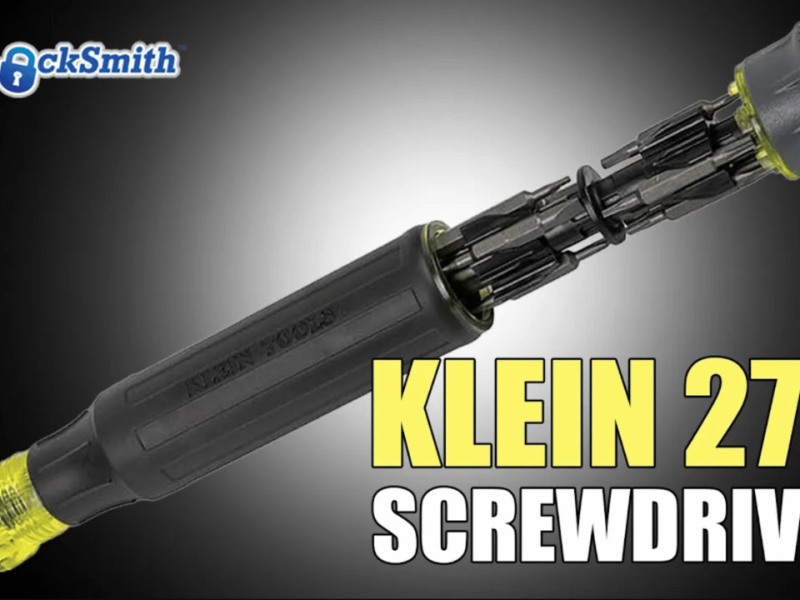Disassembling the Folger Adams 80 Series Detention Lock: Mr. Locksmith provides a step-by-step guide on dismantling the Folger Adams 80 Series Lever Lock, commonly used in detention centers. This detailed tutorial covers identifying the lock parts, proper handling procedures, and preventive maintenance tips. Learn about the common issues such as obstructions and spring breakage, and get valuable advice on how to service this heavy-duty, high-use lock effectively.
Disassembling the Folger Adams 80 Series Detention Lock
Mr. Locksmith demonstrates how to disassemble and maintain the Folger Adams 80 Series Detention Lock. He explains the importance of using the correct terminology, as it is a lever lock or detention lock. Designed for high use, the lock requires lubrication every six months. Proper maintenance includes not using oil and handling the internal components carefully. Common issues such as broken springs and blockages caused by foreign objects are discussed, along with steps to resolve them. The lock’s heavy-duty nature and durability are emphasized and a detailed overview of disassembly and reassembly procedures.
A Comprehensive Guide
Hello, my name is Terry. Today’s post is dedicated to taking apart and maintaining the Folger Adam 80 Series Prison Lock. Also known as a Detention Lock or Jail Lock, this Lever Lock is crucial in securing correctional facilities. Throughout this guide, we’ll explore its features, discuss proper maintenance, and provide a step-by-step disassembly process.
Overview of the Folger Adam 80 Series
The Folger Adam 80 Series is a heavy-duty lock, designed to endure frequent usage—up to 50 turns a day. It’s advisable to lubricate it every six months. Regular maintenance, including taking the lock apart and lubricating it properly, is essential. Avoid using oil; we’ll delve into the specifics of maintenance later.
Key Features
- Lock Type: Lever Lock (commonly but mistakenly referred to as Tumblers)
- Series: 80 Series Detention Lock
- Key Configuration: This particular model is a double cylinder lock, meaning it is keyed on both sides. Some locks might only be keyed on one side.
Disassembling the Lock
Let’s go through the process of disassembling the Folger Adam 80 Series lock. While it is straightforward, it’s essential to follow each step meticulously.
- Removing the Lock from the Door: The initial step is to remove the lock from the door, which involves unscrewing it.
- Taking Off The Cover: Once the lock is off, the cover comes off easily, revealing the internal components. Inside, you’ll find the cylinder, levers, and springs. These components are built to handle heavy-duty use and can withstand significant stress.
- Handling andCleaning: When working on a lock for the first time, always lay out each part in order. This precision is vital to avoid confusion during reassembly. It’s also crucial to wear gloves due to potential contamination. Inmates might fill the lock with foreign objects, causing obstructions. Regular cleaning can help mitigate these issues.
- Inspecting Internal Components: The levers (often called the tumbler pack in blueprints) are crucial. When the key is inserted, everything aligns, and the bolt retracts. Understanding this mechanism is vital for proper maintenance and servicing.
- Common Issues: The most frequent problem with these locks is the breaking of the springs or obstructions from foreign materials. Fortunately, replacing a spring is straightforward. Regular inspection and cleaning can prevent many common issues.
Reassembly Process
After inspection and maintenance, reassembling the lock is equally important.
- Organize Components: Lay out all parts in the order they were removed. This ensures correct reassembly and functions properly.
- Reinstall Levers: Insert each lever back into its correct place. If any levers show wear, replace them with new ones. You can order a lever pack or kit from the factory.
- Check Alignment: As you reassemble, continuously check that all parts are aligned correctly. Incorrect alignment can lead to malfunction or lockout.
- Final Assembly: Once everything is back in place, carefully reattach the cover and screw the lock back onto the door.
Maintenance Tips
Proper maintenance extends the lifespan of your lock and ensures it functions efficiently. Here are some key points:
- Lubrication: Avoid oil. Use the recommended lubricant for lever locks. Lubricate every six months.
- Clean Regularly: Disassemble and clean the lock periodically to remove any foreign materials.
- Replace Worn Parts: Regularly inspect components and replace worn parts promptly.
Addressing Lockouts and Malfunctions
Despite being rare, malfunctions can occur. Common issues include:
- Obstructions: Often caused by foreign materials inserted into the lock. Proper tools these locks is the breaking of the springs or obstructions from foreign materials. Fortunately, replacing a spring is straightforward. Regular inspection and cleaning can prevent many common issues.
Reassembly Process
After inspection and maintenance, reassembling the lock is equally important.
- Organize Components: Lay out all parts in the order they were removed. This ensures correct reassembly and functions properly.
- Reinstall Levers: Insert each lever back into its correct place. If any levers show wear, replace them with new ones. You can order a lever pack or kit from the factory.
- Check Alignment: As you reassemble, continuously check that all parts are aligned correctly. Incorrect alignment can lead to malfunction or lockout.
- Final Assembly: Once everything is back in place, carefully reattach the cover and screw the lock back onto the door.
Maintenance Tips
Proper maintenance extends the lifespan of your lock and ensures it functions efficiently. Here are some key points:
- Lubrication: Avoid oil. Use the recommended lubricant for lever locks. Lubricate every six months.
- Clean Regularly: Disassemble and clean the lock periodically to remove any foreign materials.
- Replace Worn Parts: Regularly inspect components and replace worn parts promptly.

Mr. Locksmith Training

The Online Learning and Locksmith Membership Website has:
- 157 lessons
- 7.5 hours of video content
- More info added weekly
Locksmith Course curriculum
- 157 lessons
- 7.5 hours of video content
- More info added weekly
- Introduction to Locksmithing
- Keys and Locks
- Mailbox Locks
- Locksmith Tools, tools, and more tools.
- Key & Code Machines
- Pin Kits
- Installing Locks
- Rekeying Locks
- Duplicate / Cop Keys
- Top 10 Locksmith Student Mistakes
- Smart Key Locks | Opening & Rekeying
- Storefront Locks
- Lock Picking
- Master Key Systems
- Shimming Locks
- Drilling Locks
- Opening Bathroom Doors
- Schlage Large Format Interchangeable Core (LFIC) or (FSIC)
- Covert and Overt Methods of Entry
- RV Locks: How to Make Keys to RV Locks
- Sentry Safes
- Running Locksmith Business
- Locksmith Suppliers
- Automotive Locksmithing (Coming Soon!)
Terry Whin-Yates
Terry Whin-Yates is a 3rd Generation Locksmith with over 35 years of Locksmith Experience. Also, Terry has a BA (Hons) in Criminology from Simon Fraser University.
Terrys’ 24Hr Mr. Locksmith YouTube Channel has 200,000+ Subscribers and 25+ Million Views:
Terry Whin-Yates participates in locksmith podcasts, he writes blogs and posts locksmith videos on YouTube, Social Media, Webinars and has Hands-On Locksmith courses for Law Enforcement, Beginner and Advanced Locksmiths in Canada, USA, South America and Asia.
For Locksmith Training go to Mr. Locksmith Training
Recommend Books




